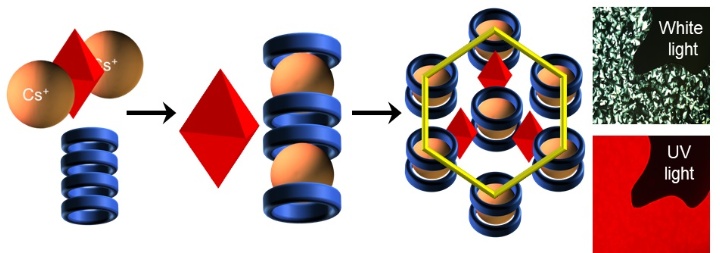Substitute for rare earth metal oxides

Embedding phosphorescent caesium metal clusters (red octahedrons) in organic liquid crystals (blue rings) produces hybrid nanomaterials that emit intense red light when irradiated with UV light. Photo: University of Stuttgart/ IOC
Nowadays energy conversion in lighting and optoelectronic devices requires the use of rare earth oxides.
However, due to their limited availability from natural resources located outside Europe rare earth oxides are considered as strategic minerals.
Therefore, alternative materials are highly desirable for energy efficient lighting and other applications.
Starting in January 2019 the Deutsche Forschungsgemeinschaft (DFG) and the French Agence Nationale de la Recherche (ANR) will be funding the Franco-German joint project SNAPSTER (Supramolecular nanomaterials containing phosphorescent transition metal clusters), which involves three research teams from the University of Stuttgart and the University of Rennes.
The aim of the SNAPSTER project is the integration of inorganic, phosphorescent metal clusters in organic liquid crystals via supramolecular interactions.
The liquid crystals are acting as isolating shell and improve the photophysical properties of the resulting hybrid materials and their chemical stability.
The emission wavelengths can be tailored by suitable choice of the metal cluster. SNAPSTER is based on the longstanding complementary expertise of the collaborating teams regarding organic material synthesis and characterization (Sabine Laschat, Stuttgart), inorganic cluster synthesis, photophysical characterization and preparation of hybrid materials (Yann Molard, Rennes) and the integration of these novel materials into electronic devices (Emmanuel Jacques, Rennes).
Sabine Laschat, Institut für Organische Chemie, Universität Stuttgart,
sabine.laschat@oc.uni-stuttgart.de
Media Contact
More Information:
http://www.uni-stuttgart.de/All latest news from the category: Life Sciences and Chemistry
Articles and reports from the Life Sciences and chemistry area deal with applied and basic research into modern biology, chemistry and human medicine.
Valuable information can be found on a range of life sciences fields including bacteriology, biochemistry, bionics, bioinformatics, biophysics, biotechnology, genetics, geobotany, human biology, marine biology, microbiology, molecular biology, cellular biology, zoology, bioinorganic chemistry, microchemistry and environmental chemistry.
Newest articles

Machine learning algorithm reveals long-theorized glass phase in crystal
Scientists have found evidence of an elusive, glassy phase of matter that emerges when a crystal’s perfect internal pattern is disrupted. X-ray technology and machine learning converge to shed light…

Mapping plant functional diversity from space
HKU ecologists revolutionize ecosystem monitoring with novel field-satellite integration. An international team of researchers, led by Professor Jin WU from the School of Biological Sciences at The University of Hong…

Inverters with constant full load capability
…enable an increase in the performance of electric drives. Overheating components significantly limit the performance of drivetrains in electric vehicles. Inverters in particular are subject to a high thermal load,…





















